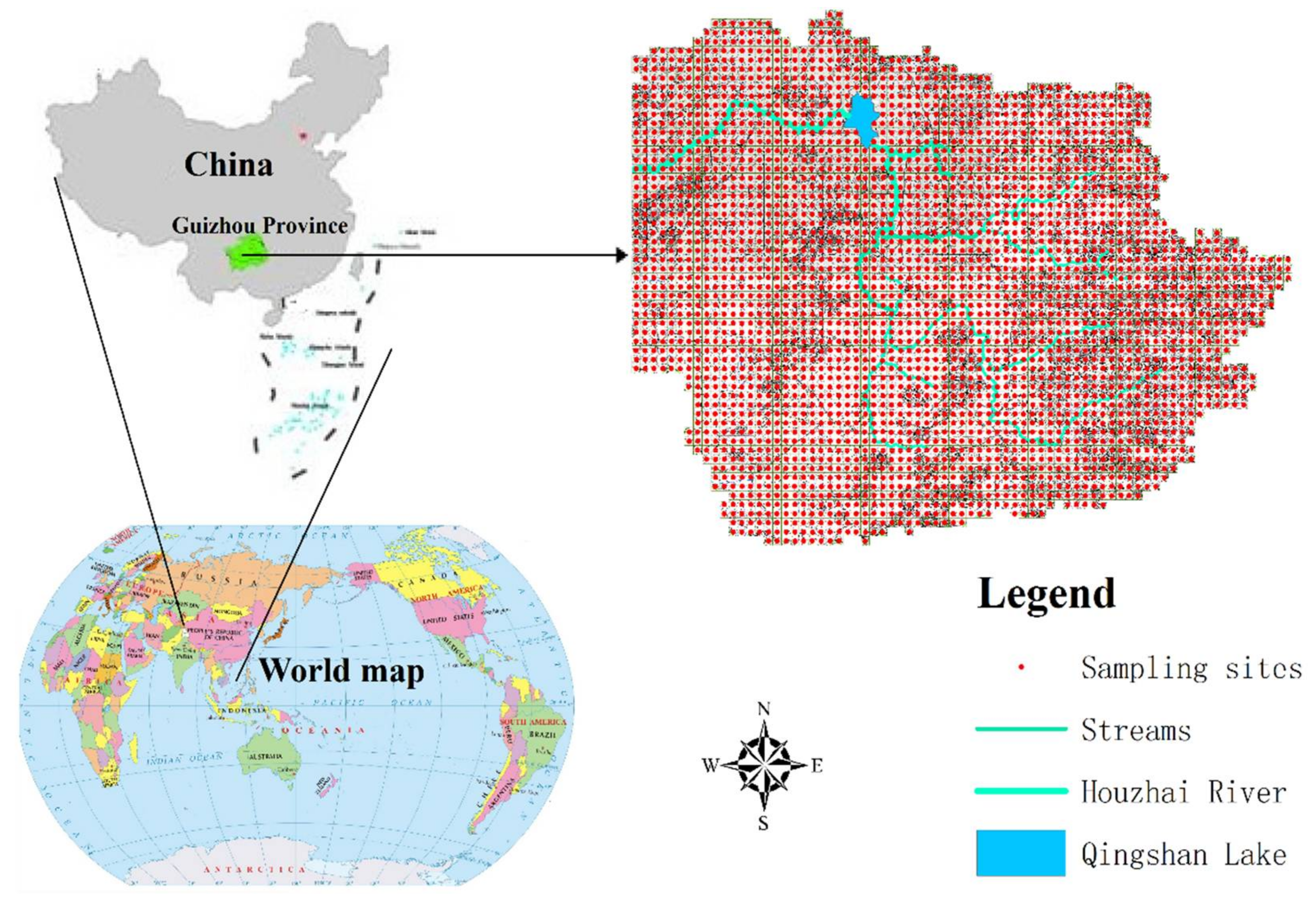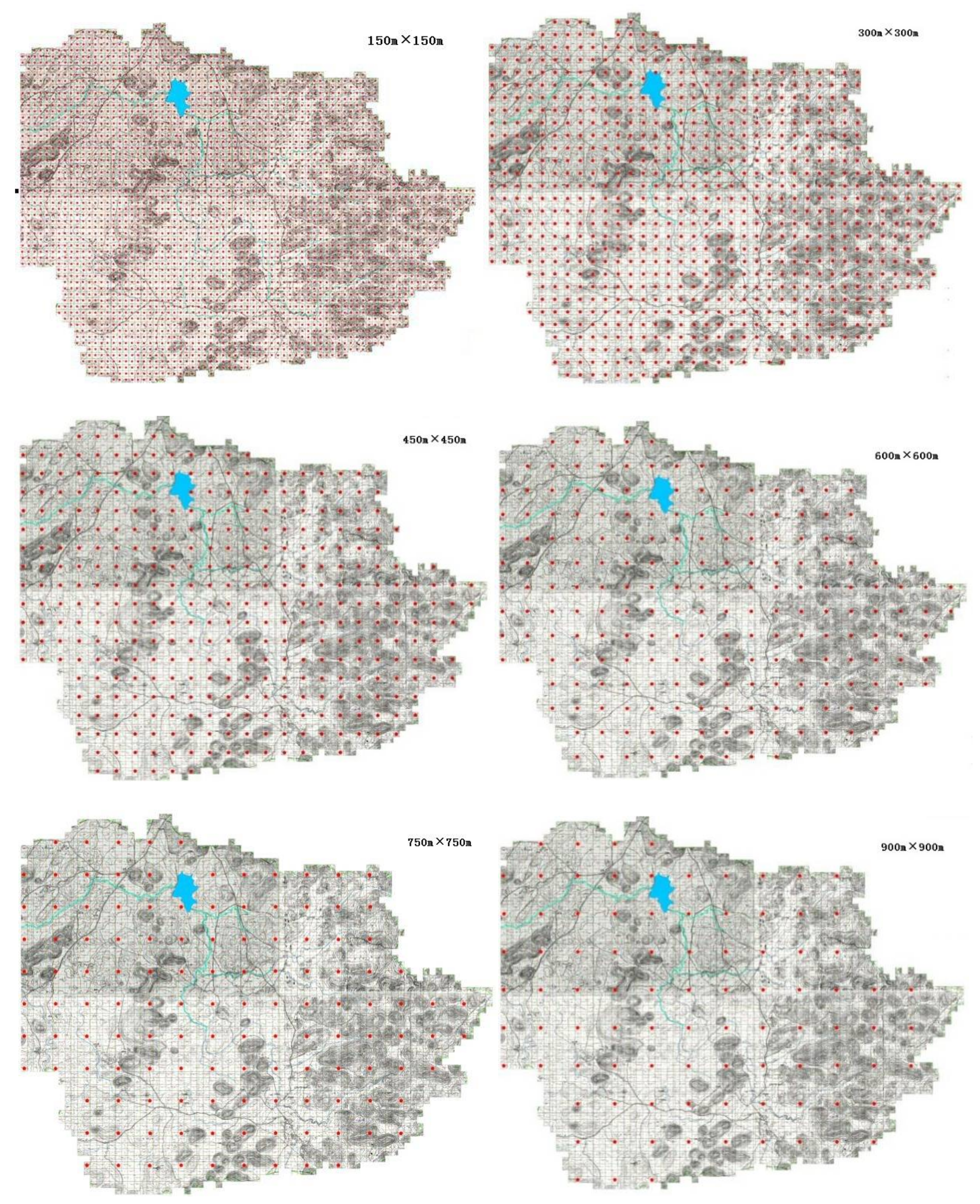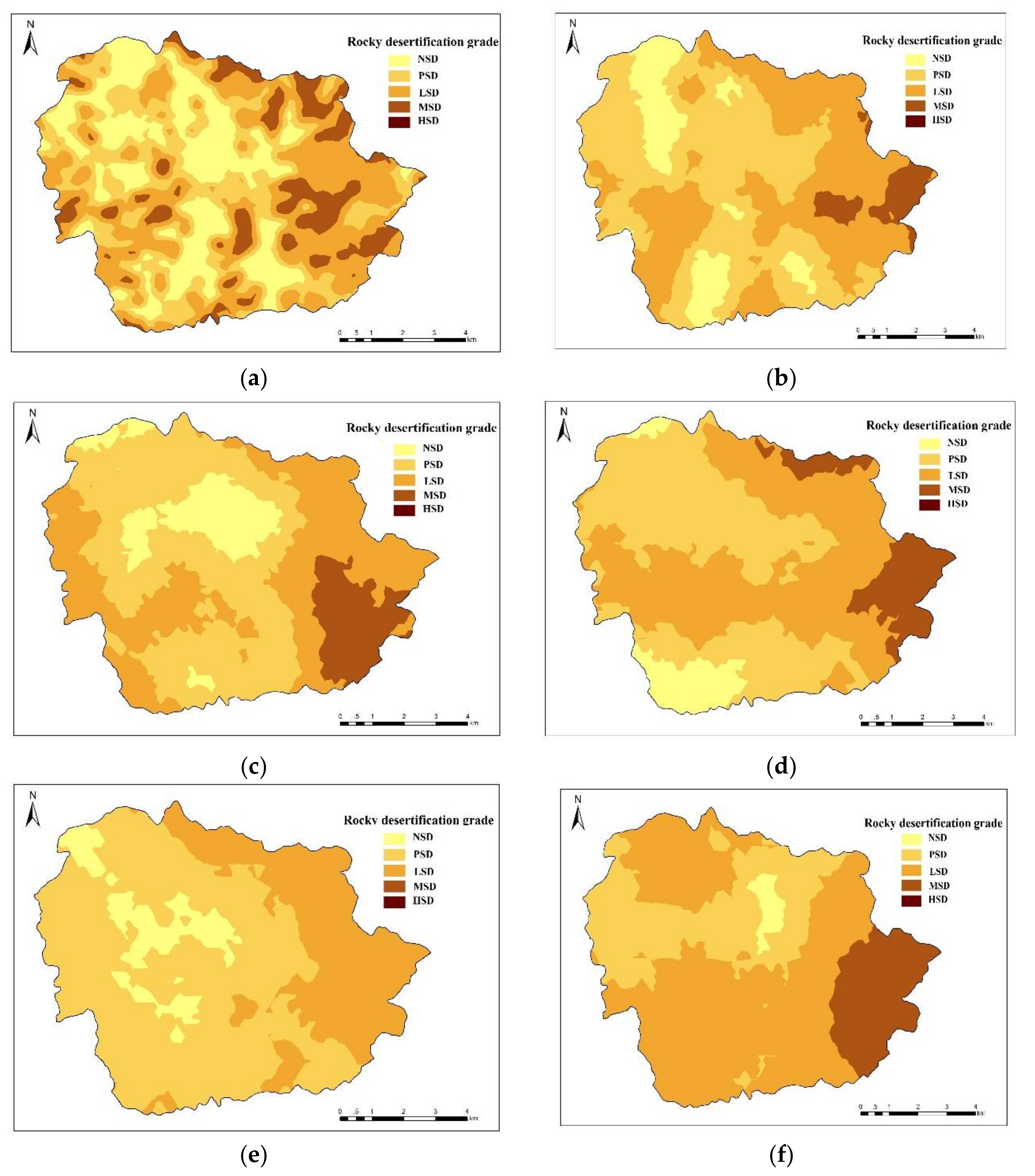Spatial Distribution of Stony Desertification and Key Influencing Factors on Different Sampling Scales in Small Karst Watersheds
Abstract
1. Introduction
2. Materials and Methods
2.1. Study Area
2.2. Data Source
2.3. Classification of Different Grid Scales
2.4. Calculations and Statistical Analysis
3. Results and Analysis
3.1. Descriptive Statistics for the Coverage of Rock Exposures at Different Sampling Scales
3.2. Semivariograms Describing the Coverage of Rock Exposures at Different Sampling Scales
3.3. Spatial Characteristics of Rocky Desertification in a Small Catchment Area in Karst
3.4. Factors Affecting the Characteristics of Rocky Desertification at Different Sampling Scales
4. Discussion
4.1. Relations between Sampling Scale and Stony Desertification
4.2. Influencing Factors of Stony Desertification at Different Sampling Scales
5. Conclusions
Acknowledgments
Author Contributions
Conflicts of Interest
References
- Kerry, R.; Oliver, M.A. Average variograms to guide soil sampling. Int. J. Appl. Earth Obs. Geoinf. 2004, 5, 307–325. [Google Scholar] [CrossRef]
- Chen, X.B.; Zheng, H.; Zhang, W.; He, X.Y.; Li, L.; Wu, J.S.; Huang, D.Y.; Su, Y.R. Effects of land cover on soil organic carbon stock in a karst landscape with discontinuous soil distribution. J. Mt. Sci. 2014, 11, 774–781. [Google Scholar] [CrossRef]
- Kerry, R.; Oliver, M.A. Comparing sampling needs for variograms of soil properties computed by the method of moments and residual maximum likelihood. Geoderma 2007, 140, 383–396. [Google Scholar] [CrossRef]
- Marcos, R.N.; Fabrício, P.P.; José, A.M.D.; Roney, B.O.; Marcelo, L.C.; Everson, C. Optimum size in grid soil sampling for variable rate application in site-specific management. Sci. Agric. 2011, 63, 386–392. [Google Scholar]
- Yu, D.S.; Zhang, Z.Q.; Yang, H.; Shi, X.Z.; Tan, M.Z.; Sun, W.X.; Wang, H.J. Effect of soil sampling density on detected spatial variability of soil organic carbon in a red soil region of China. Pedosphere 2011, 21, 207–213. [Google Scholar] [CrossRef]
- Webster, R.; Oliver, M.A. Sample adequately to estimate variograms of soil properties. J. Soil Sci. 1992, 43, 177–192. [Google Scholar] [CrossRef]
- Gascuel-Odoux, C.; Boivin, P. Variability of variograms and spatial estimates due to soil sampling: A case study. Geoderma 1994, 62, 165–182. [Google Scholar] [CrossRef]
- Heilman, J.L.; Litvak, M.E.; Mcinnes, J.M.; Kjelgaard, J.F.; Kamps, R.H.; Schwinning, S. Water-storage capacity controls energy partitioning and water use in karst 470 ecosystems on the Edwards Plateau, Texas. Ecohydrology 2014, 7, 127–138. [Google Scholar] [CrossRef]
- Li, Y.B.; Xie, J.; Luo, G.J.; Yang, H.; Wang, S.J. The Evolution of a Karst Rocky Desertification Land Ecosystem and Its Driving Forces in the Houzhaihe Area. Open J. Ecol. 2015, 5, 501–512. [Google Scholar] [CrossRef]
- Bach, M.A.; Freibauer, C.; Siebnea, C.; Flessa, H. The German Agricultural Soil Inventory: Sampling design for a representative assessment of soil organic carbon stocks. Procedia Environ. Sci. 2011, 7, 323–328. [Google Scholar] [CrossRef][Green Version]
- Wang, S.J.; Lu, H.M.; Zhou, Y.C.; Xie, L.P.; Xiao, D.A. Spatial variability of soil organic carbon and representative soil sampling method in Maolan karst virgin forest. Acta Pedol. Sin. 2007, 44, 475–483. (In Chinese) [Google Scholar]
- Xie, X.L.; Sun, B.; Zhou, H.Z.; Li, Z.P.; Li, A.B. Organic carbon density and storage in soils of China and spatial analysis. Acta Pedol. Sin. 2004, 1, 35–43. [Google Scholar]
- Liu, Z.T.; Liu, C.Q.; Lang, Y.C.; Hu, D. Dissolved organic carbon and its carbon isotope compositions in hill slope soils of the karst area of southwest China: Implications for carbon dynamics in limestone soil. Geochem. J. 2014, 48, 277–290. [Google Scholar] [CrossRef]
- Mao, D.H.; Wang, Z.M.; Li, L.; Miao, Z.H.; Ma, W.H.; Song, C.C.; Ren, C.Y.; Jia, M.M. Soil organic carbon in the Sanjiang Plain of China: Storage, distribution and controlling factors. Biogeosciences 2015, 12, 1635–1645. [Google Scholar] [CrossRef]
- Zhang, W.; Chen, H.S.; Wang, K.L; Su, Y.R.; Zhang, J.G.; Yi, A.J. The heterogeneity of soil nutrients and their influencing factors in peak-clusters depression areas of karst region. Sci. Agric. Sin. 2006, 39, 1828–1835. [Google Scholar] [CrossRef]
- Reuben, C.; Navjot, S.S.; Menno, S.; Peter, K.L.N. Limestone Karsts of Southeast Asia: Imperiled Arks of Biodiversity. BioScience 2006, 56, 733–742. [Google Scholar]
- Zhang, Z.M.; Zhou, Y.C.; Wang, S.J.; Huang, X.F. Estimation of soil organic carbon storage and its fractions in a small karst watershed. Acta Geochim. 2017, 37, 113–124. [Google Scholar] [CrossRef]
- Zhang, L.; Ren, R.; Chen, S.; Dong, P. Spatial variability of surface sediment basis on geostatistical analysis in the littoral area of Yellow River delta, China. Indian J. Geo Mar. Sci. 2014, 43, 463–472. [Google Scholar]
- Bergstrom, D.W.; Monreal, C.M.; Millette, J.A.; King, D.J. Spatial Dependence of Soil Enzyme Activities along a Slope. Soil Sci. Soc. Am. J. 1998, 62, 1302–1308. [Google Scholar] [CrossRef]
- Xiong, K.N.; Yuan, J.Y.; Fang, Y. Atlas for Integrate Protection of Karst Stony Desertification in Guizhou Province; Guizhou People’s Publishing House: Guiyang, China, 2007; pp. 26–38. (In Chinese) [Google Scholar]
- Hu, W.; Schoenau, J.J.; Si, B.C. Representative sampling size for strip sampling and number of required samples for random sampling for soil nutrients in direct seeded fields. Precis. Agric. 2015, 16, 385–404. [Google Scholar] [CrossRef]
- Rodeghiero, M.; Cescatti, A. Spatial variability and optimal sampling strategy of soil respiration. For. Ecol. Manag. 2008, 255, 106–112. [Google Scholar] [CrossRef]
- Martin, J.G.; Bolstad, P.V. Variation of soil respiration at three spatial scales: Components within measurements intra-site variation and patterns on the landscape. Soil Biol. Biochem. 2009, 41, 530–543. [Google Scholar] [CrossRef]
- Cochran, W.G. Sampling Techniques; John Wiley and Sons, Inc.: New York, NY, USA, 1997. [Google Scholar]
- Lütticken, R.E. Automation and standardisation of site specific soil sampling. Precis. Agric. 2000, 2, 179–188. [Google Scholar] [CrossRef]
- Zhang, J.Y.; Dai, M.H.; Wang, L.C.; Zeng, C.F.; Su, W.C. The challenge and future of rocky desertification control in karst areas in southwest China. Solid Earth Discuss. 2015, 7, 3271–3292. [Google Scholar] [CrossRef]
- Zhang, W.; Chen, H.S.; Wang, K.L.; Su, Y.R.; Zhang, J.G.; Yi, A.J. The heterogeneity and its influencing factors of soil nutrients in peak-cluster depression areas of Karst region. Agric. Sci. China 2007, 6, 322–329. [Google Scholar] [CrossRef]
- Wang, D.J.; Shen, Y.X.; Huang, J. Epilithic organic matter and nutrient contents in three different karst. Mt. Res. 2015, 33, 16–24. [Google Scholar]
- Wei, J.B.; Xiao, D.N.; Zhang, X.Y.; Li, X.Z.; Li, X.Y. Spatial variability of soil organic carbon in relation to environmental factors of a typical small watershed in the black soil region, Northeast China. Environ. Monit. Assess. 2006, 121, 597–613. [Google Scholar]
- Ying, B.; Xiao, S.Z.; Xiong, K.N.; Cheng, Q.W.; Luo, J.S. Comparative studies of the distribution characteristics of rocky desertification and land use/land cover classes in typical areas of Guizhou province, China. Environ. Earth Sci. 2012, 71, 631–645. [Google Scholar] [CrossRef]
- Shen, Y.X.; Liu, W.Y.; Li, Y.H.; Cui, J.W. Community ecology study on karst semi-humid evergreen broad-leaved forest at the central part of Yunnan. Guihaia 2005, 25, 321–326. [Google Scholar]
- Jiang, Z.; Lian, Y.; Qin, X. Rocky desertification in Southwest China: Impacts, causes, and restoration. Earth-Sci. Rev. 2014, 132, 1–12. [Google Scholar] [CrossRef]
- Liu, C.Q. Biogeochemical Processes and Cycling of Nutrients in the Earth’s Surface: Cycling of Nutrients in Soil-Plant Plant Systems of Karstic Environment, Southwest China; Science Press: Beijing, China, 2009; pp. 80–96. [Google Scholar]
- Wang, D.J.; Shen, Y.X; Huang, J.; Li, Y.H. Rock outcrops redistribute water to nearby soil patches in karst landscapes. Environ. Sci. Pollut. Res. 2016, 23, 8610–8616. [Google Scholar] [CrossRef] [PubMed]
- Chen, S.Z.; Zhou, Z.F.; Yan, L.H.; Li, B. Quantitative Evaluation of Ecosystem Health in a Karst Area of South China. Sustainability 2016, 8, 975–989. [Google Scholar] [CrossRef]
- Li, C.; Xiong, K.N.; Wu, G.M. Process of biodiversity research of karst areas in China. Acta Ecol. Sin. 2013, 33, 192–200. [Google Scholar] [CrossRef]



| Sampling Scales | Sample Size | Minimum | Maximum | Mean | Standard Deviation | Coefficient of Variation | Skewness | Kurtosis |
|---|---|---|---|---|---|---|---|---|
| 150 m × 150 m | 2755 | 0.00 | 95.00 | 15.94 | 22.29 | 139.84 | 1.33 | 0.79 |
| 300 m × 300 m | 802 | 0.00 | 92.00 | 12.89 | 21.42 | 166.18 | 1.90 | 1.69 |
| 450 m × 450 m | 357 | 0.00 | 88.00 | 12.18 | 20.71 | 170.03 | 1.35 | 0.78 |
| 600 m × 600 m | 200 | 0.00 | 85.00 | 11.97 | 20.51 | 171.35 | 1.99 | 1.71 |
| 750 m × 750 m | 128 | 0.00 | 75.00 | 10.22 | 17.52 | 171.43 | 2.29 | 1.72 |
| 900 m × 900 m | 91 | 0.00 | 73.00 | 9.89 | 19.55 | 197.67 | 2.52 | 1.83 |
| Sampling Scales | Model Type | Nugget (C0) | Sill (C0 + C) | Range/m | C0/C0 + C | R2 | RMSE |
|---|---|---|---|---|---|---|---|
| 150 m × 150 m | Index | 0.088 | 0.172 | 2960 | 0.512 | 0.848 | 0.673 |
| 300 m × 300 m | Index | 0.076 | 0.152 | 2350 | 0.500 | 0.831 | 0.612 |
| 450 m × 450 m | Index | 0.068 | 0.272 | 2630 | 0.250 | 0.772 | 0.478 |
| 600 m × 600 m | Index | 0.062 | 0.243 | 2140 | 0.255 | 0.636 | 0.281 |
| 750 m × 750 m | Index | 0.043 | 0.196 | 1970 | 0.219 | 0.779 | 0.222 |
| 900 m × 900 m | Index | 0.041 | 0.187 | 1860 | 0.219 | 0.782 | 0.228 |
| Sampling Scale | Slope | Elevation | Soil Thickness | Soil Bulk Density | Rock Content | Slope Position |
|---|---|---|---|---|---|---|
| 150 m × 150 m | 0.893 ** | 0.991 ** | −0.913 ** | −0.862 | 0.510 | 0.480 * |
| 300 m × 300 m | 0.721 ** | 0.512 * | −0.732 * | −0.602 | 0.610 * | 0.913 ** |
| 450 m × 450 m | 0.763 ** | 0.813 ** | 0.416 | 0.402 | 0.913 ** | 0.680 ** |
| 600 m × 600 m | 0.503 * | 0.453 | 0.436 | 0.436 | 0.684 ** | 0.406 * |
| 750 m × 750 m | 0.421 | 0.112 | 0.462 | 0.302 | 0.780 * | 0.741 * |
| 900 m × 900 m | 0.689 | 0.363 | −0.637 ** | 0.412 | 0.496 | 0.501* |
| Sampling Scale | Index | The Optimal Fitted Equation for Rock Exposures | R2 |
|---|---|---|---|
| 150 m × 150 m | Slope | y = 0.0112x + 12.539 | 0.263 |
| Elevation | y = 0.166x + 1288.201 | 0.287 | |
| Soil thickness | y = 0.0212x + 11.592 | 0.272 | |
| Soil bulk density | y = −0.0255Ln(x) + 1.1502 | 0.011 | |
| Slope position | y = 0.1x2 + 0.031x + 9.358 | 0.382 | |
| Rock content | y = 1.3256Ln(x) − 1.4693 | 0.369 | |
| 300 m × 300 m | Slope | y = 0.0194x + 22.384 | 0.343 |
| Altitude | y = 0.0194x + 1425.084 | 0.298 | |
| Soil thickness | y = 0.0194x + 15.084 | 0.349 | |
| Soil bulk density | y = 1.2081Ln(x) + 11.31 | 0.017 | |
| Slope position | y = 0.2x2 + 0.0048x + 5.695 | 0.439 | |
| Rock content | y = 1.2682Ln(x) − 12.225 | 0.428 | |
| 450 m × 450 m | Slope | y = 0.0231x + 10.148 | 0.391 |
| Altitude | y = −2.3608x + 1314.8 | 0.317 | |
| Soil thickness | y = −0.0216x + 17.978 | 0.361 | |
| Soil bulk density | y = 1.3498Ln(x) + 12.466 | 0.018 | |
| Slope position | y = 0.2x2 − 0.1014x + 0.2054 | 0.463 | |
| Rock content | y = −3.2414Ln(x) + 21.321 | 0.474 | |
| 600 m × 600 m | Slope | y = 0.0182x + 24.713 | 0.412 |
| Altitude | y = 0.131x + 1001.571 | 0.331 | |
| Soil thickness | y = 43.525 − 0.950x + 0.105x2 | 0.372 | |
| Soil bulk density | y = 1.2014Ln(x) + 13.823 | 0.020 | |
| Slope position | y = 0.0003x2 + 0.0681x + 15.567 | 0.514 | |
| Rock content | y = 1.0924Ln(x) + 21.854 | 0.548 | |
| 750 m × 750 m | Slope | y = 0.1313x + 23.153 | 0.497 |
| Altitude | y = 0.101x + 1033.201 | 0.395 | |
| Soil thickness | y = −0.1625x + 65.293 | 0.619 | |
| Soil bulk density | y = 3.1781Ln(x) + 15.597 | 0.022 | |
| Slope position | y = 0.002x2 − 0.0855x + 16.946 | 0.587 | |
| Rock content | y = 0.1313x + 22.053 | 0.649 | |
| 900 m × 900 m | Slope | y = 0.2669x − 0.0397 | 0.516 |
| Altitude | y = 0.136x + 1083.201 | 0.491 | |
| Soil thickness | y = 0.1325x + 24.78 | 0.673 | |
| Soil bulk density | y = 0.9136Ln(x) + 21.2 | 0.029 | |
| Slope position | y = 0.0023x2 − 0.1766x + 17.997 | 0.645 | |
| Rock content | y = 0.8333Ln(x) + 21.429 | 0.703 |
© 2018 by the authors. Licensee MDPI, Basel, Switzerland. This article is an open access article distributed under the terms and conditions of the Creative Commons Attribution (CC BY) license (http://creativecommons.org/licenses/by/4.0/).
Share and Cite
Zhang, Z.; Zhou, Y.; Wang, S.; Huang, X. Spatial Distribution of Stony Desertification and Key Influencing Factors on Different Sampling Scales in Small Karst Watersheds. Int. J. Environ. Res. Public Health 2018, 15, 743. https://doi.org/10.3390/ijerph15040743
Zhang Z, Zhou Y, Wang S, Huang X. Spatial Distribution of Stony Desertification and Key Influencing Factors on Different Sampling Scales in Small Karst Watersheds. International Journal of Environmental Research and Public Health. 2018; 15(4):743. https://doi.org/10.3390/ijerph15040743
Chicago/Turabian StyleZhang, Zhenming, Yunchao Zhou, Shijie Wang, and Xianfei Huang. 2018. "Spatial Distribution of Stony Desertification and Key Influencing Factors on Different Sampling Scales in Small Karst Watersheds" International Journal of Environmental Research and Public Health 15, no. 4: 743. https://doi.org/10.3390/ijerph15040743
APA StyleZhang, Z., Zhou, Y., Wang, S., & Huang, X. (2018). Spatial Distribution of Stony Desertification and Key Influencing Factors on Different Sampling Scales in Small Karst Watersheds. International Journal of Environmental Research and Public Health, 15(4), 743. https://doi.org/10.3390/ijerph15040743





